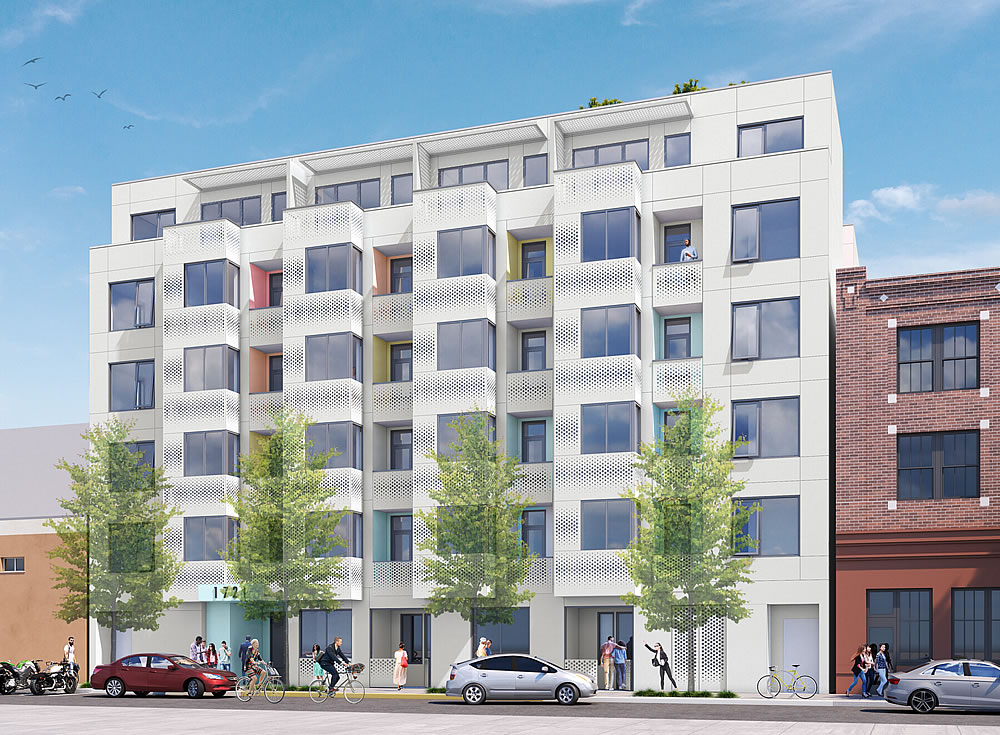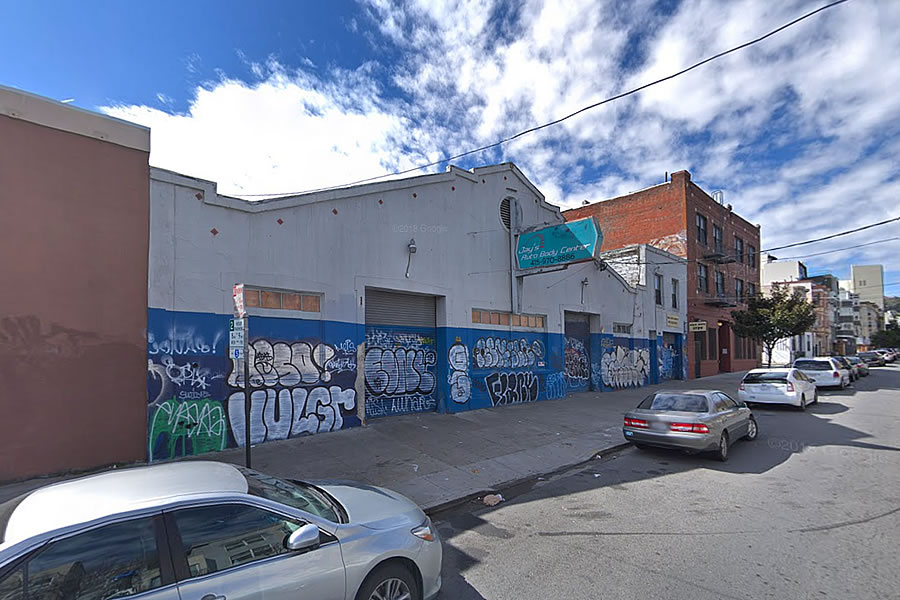Having been entitled last month, the supersized plans for a 50-unit development to rise up to 65 feet in height on the shuttered Mission District garage site at 1721 15th Street has now joined the growing list of approved developments across the city for which a buyer is being sought versus positioning to break ground, as we foreshadowed last year.
Acquired for $6.8 million in May of 2016 and subsequently entitled by Veev, which isn’t, or at least wasn’t, an entitlement shop, the 10,000-square-foot parcel and approved plans for the 39,000-square-foot development are now being marketed with an $11 million list price and projected potential sales of $44.1 million, including $4.1 million in revenue from the 13 below market rate (BMR) units as required and approved.





Panoramic view of the Valencia Gardens…..
That sounds so much better than it is. :p
This is sooooooooo far from entitled. It just got its Conditional Use approval for being over 10k feet. That is it. It doesn’t have the planning application approved, nothing has even been turned into the building department.
It doesn’t matter now, does it? If it sells to some poor sap for $11 million, the principals of the “entitlement shop” will be laughing about this all the way up the back nine of a very expensive course.
If it gets a planning application approved, then they’ll raise the asking price because the closer you get to a building permit the more the project is worth.
Well if it doesn’t sell for $11 and then doesn’t sell for $8.5M and then doesn’t sell at auction for $6 it will be a national story about the “Froth” and the “Housing Slump”, right?
(also 33 Mountain Spring from the other thread where the comments are locked)
It’ll be a story about the value of optionality. The way I look at it, the folks who acquired the property in May of 2016 bought something akin to a call option. The 39,000 ft.² 50-unit development is like the underlying security.
If they can’t sell this for their desired amount of profit before having the approved planning application in hand, approved building permit, etc. they can always proceed to obtaining those items and build out the development, continuing through to selling the $44.1 million worth of units (with the usual amount of leverage involved, of course). This would be analogous to exercising the option.
If they think that several years down the road the completed project won’t be worth the $44.1 million, then they can just decline to complete the project, and that would be like the option expiring worthless. They don’t have to sell for the entire $11 million now to avoid that outcome, they can sell for less and still come out ahead and let some other, greater fool take the risk that they won’t make $44.1 million or some smaller amount that won’t generate the desired ROI.
Thanks for the pointer to the home in Clarendon Heights. Looking at the listing, I don’t think that particular situation justifies a national story about an S.F. housing slump, although it would be wonderful if it did.
My read of the approval document leaves me with the impression that the project is now approved and entitled. I think the Planner perhaps failed to update some of the information in the database, but I have never heard of the CU being granted separately and in advance of the overall project approval.
If you read the CU document it appears to be an approval motion for the entire project.
You’re right that nothing has happened with DBI, because the current owner appears not to want to start construction themselves.
I don’t think so. As a project such as this appears with “building” entries as leading well before addenda and various departments and fees are addressed and met.
Something wrong with the printer…?
How much of a sales price increase do these entitlements offer the seller? Sure, the seller have to recover the time and expense of drawing up plans, submission of plans, wait times, and related fees and an extra something on top of that. Isn’t it almost like staging for the exterior of the property the way interior staging does. You are selling the potential when it is just land value presently.
Remain as warehouse and convert to navigation center for homelessjunkies. com ?
That and any other uses would kill off any entitlement premium.
Interim use until next economic cycle? SF homeless industrial complex has billion$ of other people’s money to throw around.
From today’s SFBT:
“State officials have had enough of San Francisco’s lagging housing production — and now, in an unprecedented move, they’re taking action.
The Department of Housing and Community Development announced Tuesday it has launched what it called a housing policy and practice review of San Francisco.
The goal will be to understand why it takes the infamously housing-short city so long to approve new residential projects. The review, a first-of-its-kind action for the department, comes as San Francisco clocked an average 450-day timeline for approving new housing projects — the longest such period in the entire state.
“We are deeply concerned about processes and political decision-making in San Francisco that delay and impede the creation of housing, and want to understand why this is the case,” HCD Director Gustavo Velasquez said in a statement.””
Well, this is going to be a short “housing policy and practice review”, unless Director Velasquez is just using this as an opportunity to concern troll, which from the above quote sounds highly likely.
The reason as to why San Francisco’s processes take longer than most other cities is pretty simple, and I suspect even Dave knows why. The overwhelming majority of projects proposed in S.F. are asking for a variance of one kind or another (yes, I am counting conditional use authorizations as a variance) and in most other municipalities, most projects submitted to the planning department are conformant and don’t require a variance, so they don’t trigger the hearings, etc and reach approval faster.
When the national news media pile on when they talk about S.F. real estate and how come S.F. can’t “just build more housing”. They never mention this fact, and The New York Times’ Ezra Klein is the worst, most prominent offender in this regard that I can think of.
And therein lies the problem. SF’s laws require CUAs for pretty much anything that would qualify as dense development. HCD is not happy about that, and God willing they will force it to change.
yep agree, and thats why zoning needs a drastic change in this city.
The reason so many variances are sought is because San Francisco’s base zoning limits are so thoroughly retrograde – written by activists in the late 1970’s and 1980’s who wanted to preserve an idea of how they imagined San Francisco looked in the early 1950’s (Herb Cane’s Baghdad by the Bay). I’m not saying that there isn’t anything worth preserving in that vision of the City. But it’s also important for any policy to be grounded in present day reality.
“450-day timeline for approving new housing projects — the longest such period in the entire state”
Wonder if that might create demand for expediter services and consulting fees?
And perhaps side business like Vegas bookies making bets on if and how long it takes a project to complete. Timeline spread: from menses to menopause. Seriously though, the ethos of SF gov’t seems to be create the problem and make people pay for the solution. No different than taxing vacant retail storefronts when city’s policies drive out businesses in the first place.
Of note, what it actually says is:
“The process for preliminary approval in San Francisco takes an average of 450 days, with 525 further dates to get permits for construction.”
There are so many issues to why it take so long. Hopefully this policy review can tackle some of them. A lot of low hanging fruit to knock off months of time in both of the prelim approval and the building permits.
In response to ” Posted by Dave (Seattle dude)”: Even though the state makes this initiative sound open-ended, it is fair to assume they already know what the outcome will be. The report is already drafted, if only in the players’ minds.
A couple interesting aspects that I see is how they have AG Rob Bonta tag along, so let’s see to what extend they’ll unpack the stick and clean up house. It’s easy pickings one would think, what with all the cronies and expediters floating around. Beyond the political spin that’s going to be put on this to try make an impression with the public, the other thing is the interests that Newsom’s in bed with. I’m not close to this, but as far as I can see, trade unions (Local 83 comes to mind) are hurting for work and have members move on to jobs elsewhere, and on the other side of the coin, there’s plenty capital on the sidelines that wants to be put to construction work.
UPDATE: Another Stalled Development Now Trying the “Auction” Route